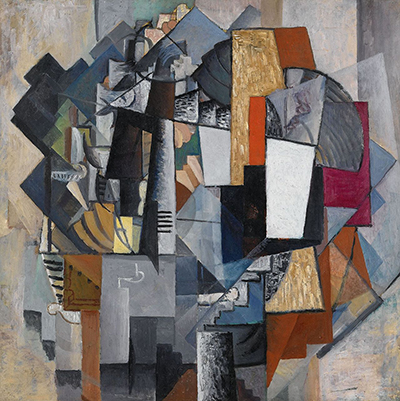Cubism and the still life genre were closely linked throughout the first half of the 20th century and in Bureau and Room, Malevich delivers his own take on this popular combination.
The artist worked on this painting in 1913, at which point he was in the midst of a devotion to Cubism which spanned a productive period of several years. Elements of this painting will remind many of more famous Cubist artists, such as Juan Gris or Georges Braque, whilst Malevich would then move on to other artistic styles and eventually become better known for other approaches. Indeed, his Suprematist work that followed remains his signature, and that involved a heavy, bold use of abstraction in which reality was pretty much left behind entirely. Examples of that series included iconic works such as Black Square, Suprematist Composition, White on White and Black Circle. That said, it would be wrong to conclude that Malevich's work within Cubism was not significant, as it certainly was. It was also important to find someone working in this way in the more traditional region of Russia, helping these ideas to spread to nations that you might expect to normally be a little late to embrace such new ideas.
The painting in front of us here features an extraordinary myriad of shapes, colours and lines. It is hard to understand where the focal point of the piece resides, and instead we simply browse the various elements of detail which cover the entire composition. Some items which pop out specifically include some gold paint which can be seen in individual brushstrokes and adds a stylish finish. There is also a bright white rectangle which stands out on the right hand side, in contrast to the black shapes which surround its lower half. Much of the background, or what one assumes to be the background, is covered in a more dull series of tones, such as grey or beige in order to lead our eyes towards the busy mass which covers the centre of the composition.
Bureau and Room can be found within the collection of the Stedelijk Museum, Amsterdam, Netherlands and the painting itself dates to around 1913. It was not long before the artist moved on again, stylistically, and few people have managed to take on quite so many different forms of modern art within their careers as Malevich. Although he would run into resistance within his native Russia from time to time, particularly so in his later years, he was able to achieve prominence which has passed the test of time and today he is celebrated within a number of major Russian art galleries and museums, underlining how the mainstream has eventually accepted his work. The spread of these modern art styles has ensured that his legacy spreads internationally today, and those who collect his work spread right across the globe.




